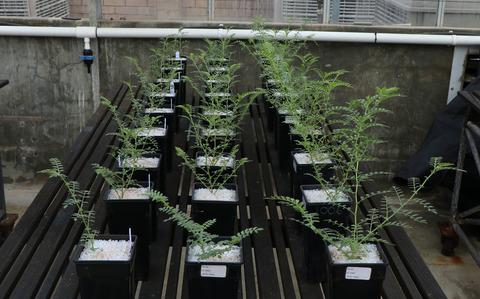当前位置:
X-MOL 学术
›
Funct. Ecol.
›
论文详情
Our official English website, www.x-mol.net, welcomes your
feedback! (Note: you will need to create a separate account there.)
Contrasting patterns in biomass allocation, root morphology and mycorrhizal symbiosis for phosphorus acquisition among 20 chickpea genotypes with different amounts of rhizosheath carboxylates
Functional Ecology ( IF 4.6 ) Pub Date : 2020-04-29 , DOI: 10.1111/1365-2435.13562 Zhihui Wen 1, 2, 3, 4, 5 , Jiayin Pang 1, 6 , Guillaume Tueux 7 , Yifei Liu 1, 2, 8 , Jianbo Shen 3, 4, 5 , Megan H. Ryan 1, 6 , Hans Lambers 1, 2, 3, 4, 5 , Kadambot H. M. Siddique 1, 6
中文翻译:

不同根际石of羧酸盐含量的20种鹰嘴豆基因型中磷吸收的生物量分配,根系形态和菌根共生的对比模式
更新日期:2020-04-29
Functional Ecology ( IF 4.6 ) Pub Date : 2020-04-29 , DOI: 10.1111/1365-2435.13562 Zhihui Wen 1, 2, 3, 4, 5 , Jiayin Pang 1, 6 , Guillaume Tueux 7 , Yifei Liu 1, 2, 8 , Jianbo Shen 3, 4, 5 , Megan H. Ryan 1, 6 , Hans Lambers 1, 2, 3, 4, 5 , Kadambot H. M. Siddique 1, 6
Affiliation

|
- Adjustments in root biomass allocation, root morphology, carboxylate exudation and mycorrhizal symbiosis are well‐known strategies for plants to cope with phosphorus (P) deficiency. Large genotypic variation in these functional traits has been demonstrated within numerous species. Yet, whether these functional traits are coordinated differently among genotypes of a species to enhance P acquisition remains unknown.
- We characterized 11 root functional traits associated with P acquisition in 20 chickpea genotypes with contrasting amounts of rhizosheath carboxylates, grown in a glasshouse with severely limiting insoluble (10 mg/kg FePO4), moderately limiting soluble (10 mg/kg KH2PO4) and adequate (50 mg/kg KH2PO4) P supply.
- Substantial variation was found among genotypes in root functional traits associated with P acquisition. Genotypes with a large amount of carboxylates (HRC) had thinner roots, and a lower root mass fraction and root mass density (RMD), but higher specific root length (SRL) and colonization by arbuscular mycorrhizal fungi (AMF) than genotypes with a small amount of rhizosheath carboxylates.
- In response to soil P availability, chickpea genotypes showed large plasticity in root biomass allocation, rhizosheath pH, carboxylate amount and colonization by AMF, but a limited response in most root morphological traits (i.e. mean root diameter, RMD and SRL). Shoot P content was strongly correlated with different root functional traits in the three P treatments.
- Our findings suggest a range of predictable relationships between root functional traits among chickpea genotypes; those with HRC tended to have relatively thinner roots with lower cost of root construction, while allocating more resources to carboxylate exudation and colonization by AMF. The shift in the relationships between shoot P content and root functional traits indicates that root traits and/or trait combinations in chickpea vary in a manner that enhances P acquisition under specific soil P conditions (i.e. P sources/levels). Such knowledge provides valuable information for chickpea genotype breeding and our understanding of evolution of traits with improved root/rhizosphere functioning.
中文翻译:

不同根际石of羧酸盐含量的20种鹰嘴豆基因型中磷吸收的生物量分配,根系形态和菌根共生的对比模式
- 根系生物量分配,根系形态,羧酸盐渗出和菌根共生的调整是植物应对磷(P)缺乏的著名策略。这些功能性状的大型基因型变异已在众多物种中得到证实。然而,这些功能性状是否在物种的基因型之间进行不同的协调以增强磷的吸收仍是未知的。
- 我们表征了在20种鹰嘴豆基因型中与磷获取相关的11个根功能性状,具有相对数量的根茎羧酸盐,生长在严格限制不溶物(10 mg / kg FePO 4),中等限制可溶物(10 mg / kg KH 2 PO 4)的温室中)和足够的(50 mg / kg KH 2 PO 4)P供应量。
- 在与磷获取有关的根部功能性状的基因型之间发现了显着差异。具有大量羧酸盐(HRC)的基因型具有较细的根,具有较低的根质量分数和根质量密度(RMD),但比根系较小的基因型具有更高的比根长度(SRL)和丛枝菌根真菌(AMF)定植量的根茎上的羧酸盐。
- 响应于土壤磷的有效性,鹰嘴豆基因型在根生物量分配,根茎pH,羧酸盐量和AMF定殖方面显示出较大的可塑性,但在大多数根形态特征(即平均根直径,RMD和SRL)中响应有限。在三种磷处理中,地上部磷含量与不同的根部功能性状密切相关。
- 我们的发现表明,鹰嘴豆基因型之间的根部功能性状之间存在一系列可预测的关系。那些拥有HRC的人往往具有相对较细的根,且根构建成本较低,同时分配更多的资源来通过AMF羧化渗出和定植。苗中磷含量与根部功能性状之间关系的转变表明,鹰嘴豆中的根性状和/或性状组合发生变化,从而在特定的土壤磷条件下(即磷源/水平)提高了磷的吸收。这些知识为鹰嘴豆基因型育种和我们对具有改善的根/根际功能的性状进化提供了有价值的信息。











































 京公网安备 11010802027423号
京公网安备 11010802027423号